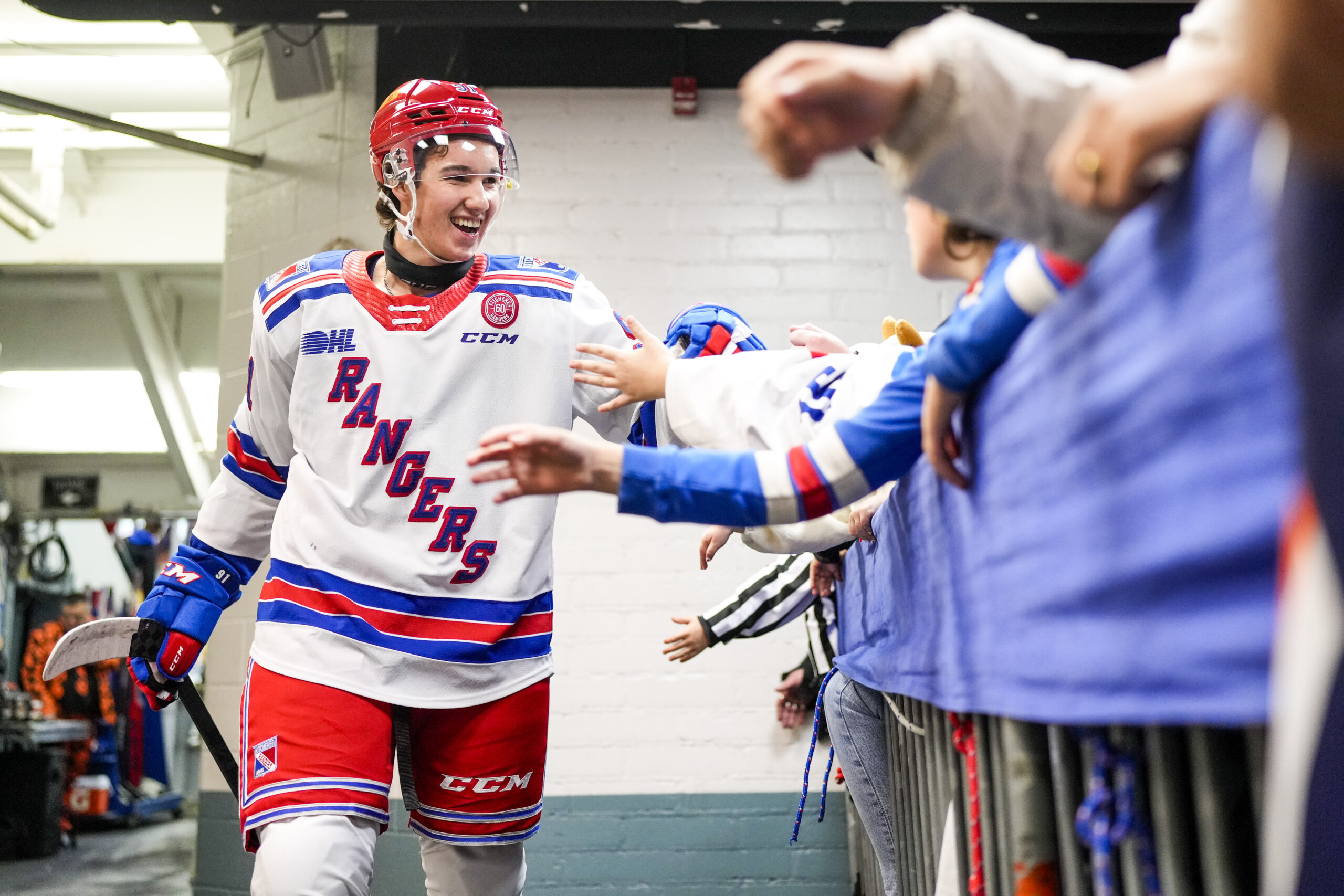Photo credit: https://chl.ca/ohl-rangers
As we all know, not all prospects tend to develop at the same rate. Therefore, every year, there tends to be a new crop of late bloomers who may have just been average in their draft year, and either hit a growth spurt or put in work one-off season, and POOF all of a sudden, they become dominant in whatever league they are currently playing in.
Then and only then, when an unclaimed player with this kind of jump in production pairs that with the unrelenting determination and work ethic that matches that of the professionals, will an NHL club even start to think about giving them another chance because teams are often too busy trying to find younger talent.
Still on the rare occasion for players like former Prospect Watch guest Ryan McAllister and Yaniv Perets, who I highlighted in a similar article last year ( that you can find below).
There comes an opportunity to sign an entry-level deal with an NHL club. While risky, signing this type of player can offer a team an instant upgrade to a position of need. While other players who those teams draft may show promise, they are often in need of more seasoning before turning pro. These undrafted prospects, on the other hand, are generally a couple of years older and, therefore, have already proven themselves to be more than capable of providing the team with the kind of depth and production they need now.
So, without further ado, here are some possible forgotten prospects in no particular order that I feel might just be worth NHL teams taking a second look at.
Matthew Sop
This 20-year-old who currently plays for his hometown team, the Kitchener Rangers of the Ontario Hockey League (OHL), may not have been able to produce the kind of numbers in his draft year that would have caught scouts’ eyes. Still, he has since continued to work to get better each and every day and to prove that all you need to do is compare his stats from last year to this year.
Last season, this 6’0, 183-pound winger was able to put up a moderately impressive 23 goals and 33 assists for a total of 56 points in 67 games played. But Sop has already managed to seemingly match those numbers through just 34 contests so far this season. His totals to date this year are 22 goals and 31 assists for 53 points. To show just how good of a season Matthew has had this year, let us look ahead to what he will end up with this season if he is able to continue on this 1.56-point-per-game pace. If this is the case, Sop will look to finish the year with 44 goals and 62 assists, totaling 106 points.
While Matt may never find himself to be the most skilled player out on the ice, he does manage to somehow offer extreme value to every team he plays for. And this is just my theory, but perhaps it may prove to be his unrelenting work ethic from constantly having to prove himself over the years (from having to wait until the seventh round of the OHL Draft to be selected by the Rangers and him being passed up by every NHL team) that will allow this long-awaited prospect the chance to finally achieve his goal of earning a professional contract.
Collin Graf
Why this now 21-year-old prospect did not get offered a pro deal after winning an NCAA National Championship last season with Quinnipiac University, where he finished with 21 goals and 38 assists, scoring a total of 59 points in only 41 games played, is beyond me. But somehow, he has not let that bother him, as he is currently on pace to best those numbers by scoring at a league-leading rate of 1.91 points per game this season.
In addition to Collin proving that he can score with the best of them, he also possesses some other noteworthy qualities prospecting NHL teams may be looking for, like the size and strength needed for a club to insert him promptly into their NHL lineup upon signing him given the fact he currently stands at 6’1 and 194 pounds. Not to mention the fact that if signed, Graf (who is a combined +45 over the last two seasons) would immediately be able to step into a penalty-killing role as he has already mastered the art of being defensively responsible, which is a must if you’re playing for his head coach Rand Pecknold.
In saying all this, it would not surprise me a bit if, directly following the conclusion of the Bobcats season, when Collin exits the ice, he will already have multiple teams having left messages on his phone before he even manages to get his skates off, for it is rare that your able to find all these qualities wrapped up into one player nowadays.
Gabe Klassen
What’s not to love about this prospect? Gabe Klassen, who is a 20-year-old centerman that plays for the Portland Winterhawks of the Western Hockey League, possesses a shot that most players playing in the NHL right now could only wish they had. It doesn’t matter if the situation calls for a wrist shot, slap shot, snapshot, or a backhand. Gabe simply has no problem putting the puck on net.
But in addition to him scoring 30+ goals in each of the last two seasons (and being on pace to do so once again this year), Klassen has shown that he can play the role of the setup man as well, with that statement being never more accurate than it is this season where he has already managed to accumulate 41 assists in just 32 games played thus far.
Like most of these prospects listed in this article, Gabe has taken a huge step forward this season. In fact, if he continues on this 1.81-point-per-game pace, he is on right now. Klassen is destined to finish the year with 36 goals and 87 assists for a combined 123 points, which would best his previous career high in points by more than 50!
If signed to an entry-level deal by an NHL club after the season, Klassen would instantaneously make that club’s offense better. Not only would he provide an additional ten shots a night to the teams’ totals, but with his Hockey IQ currently measuring off the charts, he is bound to make everyone around him better.
Josh Nadeau
That last name sounds familiar, doesn’t it? Yes, Josh is related to Bradley Nadeau, who was drafted in the 1st round this past summer by the Carolina Hurricanes. Both of them played for the Penticton Vee’s of the British Columbia Hockey League for the two seasons prior to this one. In each of those seasons, they were able to raise a banner for the Vee’s as their telepathic-like nonverbal communication and awareness of where each other are on the ice at all times helped the team win back-to-back league championships.
I assure you, though, that Josh is not just riding on his younger brothers’ coattails. While he may not have been fortunate enough to be selected by an NHL club in his draft year, he has managed to put the same number of points or better than his younger sibling. Take, for instance, last season. A large part of Bradley’s being taken in the first round by the Canes was the fact that he was able to compile 45 goals and 113 points during the regular season. Then he managed to add another 35 points in 17 playoff games. Well, Josh was able to put up 44 goals and 110 points during the regular season and bested his brother in the playoffs, where he netted 36 points in 17 games.
So, it should go without saying that I was absolutely baffled when I heard that this 146-point scorer from last season was forced to walk away from the Hurricanes camp this fall (where he was brought in as an invitee) without a contract.
But I guess when you’re a 5’8 diminutive type player, you get used to having to prove your doubters wrong. Because that’s precisely what he has been doing this year while playing for the University of Maine Black Bears. Josh currently leads his brother and the rest of the team in points, with him scoring ten goals and 12 assists for 22 points through just 14 games played.
While he is still a free agent at this point, I think Carolina would be wise to sign him in order to ensure that if both brothers end up making it to the NHL, they could reap the benefits of the lifelong chemistry these two have been building dating back to when they first strapped on a pair of skates.
Any one of these players, if signed, could make an immediate impact, whether it be in the capacity of an NHL player for a struggling franchise or serving as more of a depth player who will be made to prove himself first at the AHL level for a playoff-caliber team. The best part about it, though, is bringing them in won’t cost the club that signs them any draft capital in which to acquire them. Just a roster spot and a contract and a team in need can have a plug-in player that is ready to produce now.








